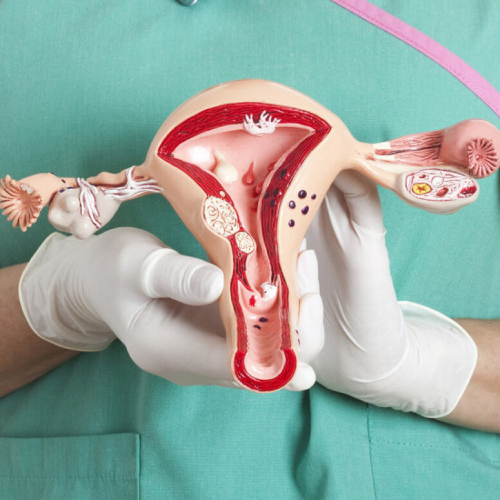Does Chocolate Cyst Cause Cancer?
The effect of chocolate cyst is seen in 30% of infertility cases, which can be seen in 15% of every woman of reproductive age and therefore cannot have children.

Endometriosis is the condition where the tissue (endometrium) in the uterus and forming the menstrual bleeding is located in a different part of the body outside the uterus. Chocolate cysts, which are formed by endometriosis in the ovaries, are a disease that usually manifests itself with chronic pain and infertility problem.
In this case, we can reassure our patients, who are panicked by cancer concerns, by saying that chocolate cysts are generally benign cysts. The chance of it turning into cancer is almost non-existent. But it can be challenging to deal with some of the symptoms of chocolate cysts from time to time.
Pain in the abdomen and groin may occur, especially during menstrual periods or during sexual intercourse. These pains can increase their severity and negatively affect your life. In such cases, your doctor will help you. Be careful not to delay your examinations.
Chocolate cyst symptoms and problems
The main place where the disease is caused is the ovaries of the woman. It can occur in the Douglas space behind the uterus, the end of the vagina and intestine, the surface of the intestine, over and around the fallopian tubes, bladder, ligaments holding the uterus, and peritoneum.
Symptom of the disease; They are understood as a result of the inflammation they show in settlement centers. In their healing, the surrounding tissues get closer to each other and adhesion occurs. Since this cycle is experienced in every menstrual period, it accumulates over time and forms cystic structures. Due to the damage caused by the centers, problems such as the transport of eggs and sperm cells in the woman's tubes, ovulation problems in the ovaries and the implantation of the fertilized egg in the uterus may occur. These are the most important factors that cause women to experience infertility problems.
In addition to the effect of chocolate cyst on infertility, there may be problems such as causing pain during menstrual periods and sexual intercourse, and chronic inguinal pain. While this ailment affects everyone differently, for some, it may progress silently without causing any problems. It is not possible to know the effects in women beforehand. Some women experience severe effects, while others may experience mild adverse effects.
Chocolate cyst and ovarian cancer
The coexistence of chocolate cyst and ovarian cancer, genetic characteristics and environmental factors can also meet in common. It has been said that ovarian cancers, especially endometrioid and clear-cell types, are seen with a ratio of 1.32 to 1.9 in those with chocolate cyst problems. While a woman's lifetime risk of developing ovarian cancer is 1% , it has also been proven that she has a 1% risk of developing ovarian cancer with a chocolate cyst. As a result of these studies, scientific results have been obtained that the fact that women have endometriosis does not have an effect on the risk of ovarian cancer.
This result may change with the effect of socioeconomic status, location of the tumor and some factors. The effect of chocolate cyst on ovarian cancer varies according to the following factors.
- Long-term use of birth control pills reduces the risk by 40%.
- While the risk decreases by 40% in pregnancies that have completed the day, the risk decreases gradually in each pregnancy.
- The risk is reduced by 50% in women whose ovaries are left and their uterus is removed or ovarian ducts are attached.
- If one of the ovaries is removed, the incidence of cancer does not change.
- It is thought that the drugs used to stimulate the ovaries, especially in infertility cases, increase the risk.
- Having a family history of breast or ovarian cancer increases the risk of ovarian cancer.
- 1 out of every 3 women with positive BRCA1 and BRCA2 genes is at risk of ovarian cancer.
- While the risk of ovarian cancer increases with age, it peaks in the mid-60s. While ovarian cancer is extremely rare in young women, it occurs in 5 out of every 10 000 women under the age of 30.
Does chocolate cyst cause cancer?
Chocolate cyst is a benign cyst and the chance of it turning into cancer is almost negligible. In addition, chocolate cysts sometimes greatly reduce the quality of life of patients with pain in the abdomen and groin felt during any period, menstrual period or sexual intercourse. Chocolate cyst does not have any negative effects in IVF treatments. However, chocolate cysts are among the gynecological diseases that should be considered. Endometriosis, that is, chocolate cysts, is usually seen in women over the age of 35, and its cause has not been fully determined today. Chocolate cysts are seen in 15% of women of reproductive age and in 30% of women who have trouble conceiving a child. Endometriosis is called a chocolate cyst because the liquid inside the cysts is chocolate-colored.
Chocolate cyst can be detected by chance in women who do not have any symptoms and during an examination performed for other reasons. Chocolate cyst, which manifests itself with pain from the abdomen and groin in some women, may not always show symptoms. This problem usually occurs with the follow-up of women who go to the doctor with severe pain during sexual intercourse and menstrual periods. In terms of genetics, women with chocolate cysts in their close relatives have a 7 times higher risk of chocolate cyst. For this reason, we strongly recommend that women at risk and those who cannot become pregnant should be evaluated in terms of chocolate cyst.
Why does a chocolate cyst target the ovaries?
Approximately 75% of endometriosis foci affect the ovaries. Endometriosis occurs when menstrual blood flows through the fallopian tubes into the abdominal cavity. Since the ovaries are at the ends of the fallopian tubes, they are inevitably the organs most affected. In addition, high amounts of steroid hormones in the ovaries also have a share in the risk of developing this disease. By causing bleeding on the ovary and spreading the wounds here to the ovarian tissue, cysts with clotted dark blood occur. These form the chocolate cyst.
You can visit our Youtube page to get fast and accurate information on personalized in vitro fertilization treatment, pregnancy follow-up, IVF, gynecology, drug use trainings, and many more .
Gynecology, In Vitro Fertilization, Pregnancy and Reproductive Immunology pages.

